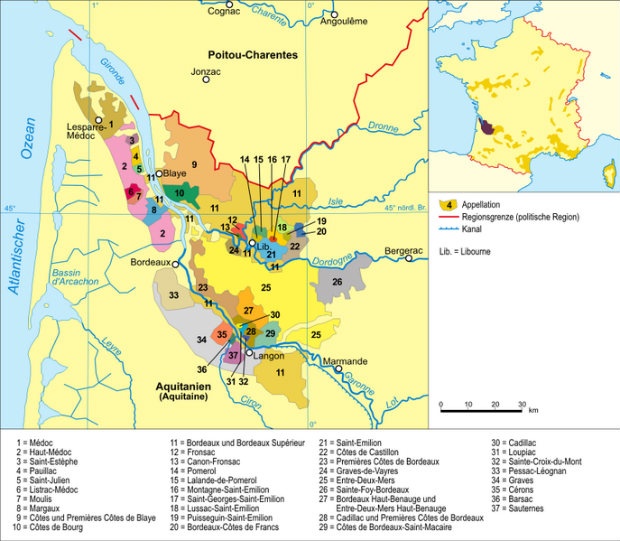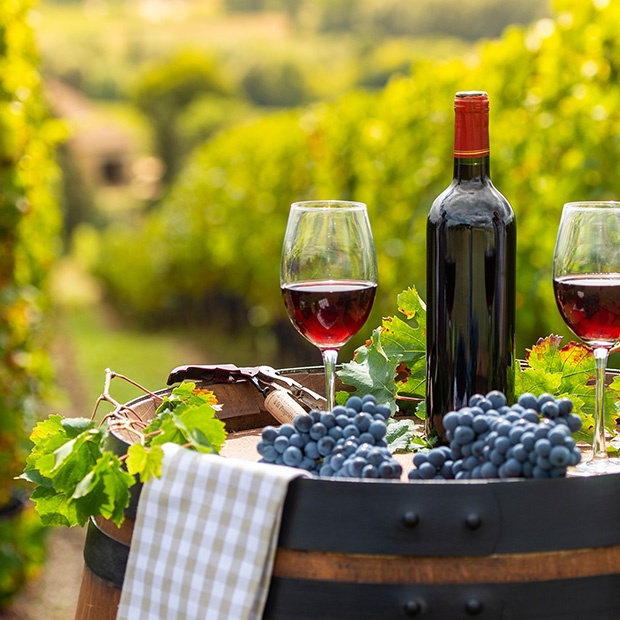Of the world’s great wine regions, Bordeaux often sits at the very top. Its best wines are among the most expensive and highly praised wines in the world. These wines set the bar so high, they’re often the reference point by which other wines are judged.
But Bordeaux is much more than just ultra-expensive and impossible-to-get collector’s items. It’s not just one of the world’s great wine-producing regions, it’s also one of the largest, offering a myriad of different wines to satisfy just about any palate and any budget.
The region can seem a little daunting to those who have never been there. But once you know a few basics about the region and its wines, Bordeaux is surprisingly easy to navigate. Here’s everything you need to know to make sure your Bordeaux trip doesn’t go sideways.
What's the difference between the Left Bank and the Right Bank in Bordeaux?
At over 120,000 hectares under vine, Bordeaux is France’s largest vineyard area, producing about 700-million bottles of wine a year. The easiest way to understand Bordeaux is to understand the region’s geography.
Bordeaux surrounds the estuary of the Gironde, Dordogne and Garonne Rivers near France’s west coast. The region is divided into those areas on either side of this estuary. Those on the west side are referred to as the “Left Bank” and those on the east side are referred to as the “Right Bank”.
When deciding on where to go in Bordeaux, the first things you want to know about are the differences between the Left Bank and the Right Bank.
Looking at the map above, you can see the distinction created by the estuary. Medoc, St. Estephe, Paulliac, St Julien, Haut Medoc, Margaux and Pessac Leognan are the principal areas, or appellations as they are called in France, of the Left Bank. The distinguishing feature of the Left Bank is the dominant grape varietal grown there.
France’s world-famous Cabernet Sauvignon? Yup, it’s from the Left Bank
Throughout Bordeaux, wines are made of a blend of grapes as opposed to from a single varietal (one type of grape) which is more common around the world. The Left Bank is Cabernet Sauvignon country. This varietal makes up between 60% to 80% of the blend, with supporting notes coming from Merlot, Cabernet Franc, Petite Verdot and Malbec.
The wines here are the envy of the Cabernet Sauvignon growing world. The Left Bank is home to names like Chateau Lafite Rothschild, Chateau Latour and Chateau Margaux, wineries that have been producing for centuries and are among the most collectible and most expensive in the world. But mixed in with them are many “lesser Chateaux” that produce delicious wines at affordable prices.
Cabernet Sauvignon in Bordeaux is known for its deep colour and its black currant flavours, its secondary notes of cedar and earthiness. The tannins in these wines can be quite prominent and contribute to their ageability.
As you travel south along the Left Bank from St. Estephe you should notice a slight shift in the style of the wines. Those cedar notes will gradually take on a more floral character (think violets) and the tannins may be a little less aggressive. Different styles for different palates.
Grand Estates of the Left Bank
One of the great features of the Left Bank is the size of its estates. Many can be quite large, in the 50 to 80 hectare range, and some of the chateaus on them can be exquisite, such as the famed Chateau Margaux.
It’s not known for it, but the Left Bank does produce a small quantity of Sauvignon Blanc
The Left Bank flows with Cabernet Sauvignon. But what about its little sister, Sauvignon Blanc? Found mainly in the southernmost part of Bordeaux, the region’s Sauvignon Blanc just doesn’t get the same attention, though it deserves its own recognition.
Blended with Semillon, Sauvignon Blanc in Bordeaux is a rich-tasting wine of class and distinction. Spectacular dessert wines from Sauternes and Barsac are made from the same white grapes, and shouldn’t be missed. Same for Chateau d’Yquem from Sauternes, which is often reviewed as the greatest sweet wine in the world.
Merlot rules the Right Bank
The Right Bank’s primary appellations are shown on the right side of the map: Blaye, Bourg, Pomerol and St. Emilion. Whereas the Left Bank is Cabernet country, the Right Bank is dominated by Merlot. Slightly cooler temperatures, less gravel and more clay in the top soils of the Right Bank account for the difference in the grapes planted.
Here, Merlot grows as well as anywhere in the world and will make up 60% to 90% of the blend. Cabernet Franc usually makes up the balance with the other blending grapes often playing no role at all. These wines are prized for their soft, lush textures and rich dark cherry and plum flavour profile. Tannins are typically less aggressive in these grape varietals and can account for their ability to drink well at an earlier age.
The vignerons, or winemakers, of the Right Bank like to point out their peasant roots in contrast to the very aristocratic Left Bank. They refer to their much smaller estates (5 hectares being about the norm with almost none over 10 hectares) and their lack of grand chateaus.
But don’t let this outward modesty fool you: the Right Bank is home to some of the most coveted collector wines in the world. Names like Petrus, Lafleur, Le Pin, Cheval Blanc and Ausone can cost as much, and in some cases, twice as much as the top wines from the Left Bank.
Meanwhile, wine produced between the Left Bank and Right Bank...
Between the Left and the Right Bank, and to the south of them, sits Entre Deux Mers. This area does both red and whites of easy drinking, value priced wines. While they produce perfectly acceptable wines, they are generally not wines of distinction.
Travellers from North America going all the way across the Atlantic to taste and learn about wine are likely going to want to spend most of their wine tour in the Left and Right Bank appellations upon which the reputation of Bordeaux was built.
How does the Bordeaux classification system work?
Since 1855, under the auspices of Emperor Napoleon III, the Bordeaux classification system has been assigning class distinctions to every winery in the region. Each Bank has its own separate system:
- The Left Bank has six classifications. At the bottom of the hierarchy are the Cru Bourgeois; the most affordable, entry-level wines. Above them are the Fifth Growth wines: these are wines of distinction and are more expensive than the Cru Bourgeois. Moving up from there are Fourth Growths, Third Growths, Second Growths and finally, at the top, are the First Growths.
- There are now 61 Left Bank wines in the classification, five of which have the distinction of being First Growths. While the relationship is not necessarily linear, price and classification are closely correlated.
- The Right Bank does not have a similar classification covering all of its appellations, except for St. Emilion. Created 100 years after the Left Bank’s classification, St. Emilion has just three classifications: the best being Premier Grand Cru A (which hosts four wines) followed by Premier Grand Cru B (14 wines) and Grand Cru Classe (63 wines).
- Pomerol and the other Right Bank appellations have no classification system.
Key differences in varietals between the Left Bank and the Right Bank
| LEFT BANK | |
| Grape | Cabernet Sauvignon with small amounts of Merlot, Cabernet Franc, Petite Verdot and Malbec. Tiny amounts of white wine and luscious dessert wines. |
| Soil | Gravel over limestone bedrock |
| Flavour profile | Black currant, cedar, minerals, floral, structured |
| Estates | Large size, grand structures |
| Location | West side of Gironde estuary |
| RIGHT BANK | |
| Grape | Merlot with Cabernet Franc. |
| Soil | Clay over limestone bedrock |
| Flavour profile | Dark cherry, plum, soft, rich |
| Estates | Small size, no large Chateaux |
| Location | East side of Gironde estuary |
Bordeaux is a fascinating wine region to visit. It’s approximately a three-hour drive southwest of Paris. Enjoy big, structured Cabernet Sauvignon wines showing black currants on the Left Bank, soft, rich Merlot-based wines showing dark cherry and plum on the Right Bank, and delicious dessert wines just to the south. You’ll be among some of the world’s greatest and most historic wines.
With no shortage of cafes and restaurants, 18th-century architecture, and art museums, you’ll never be bored in Bordeaux. Talk to an Expert Traveller about this famed wine region and start planning your trip to France. Call us at 1-877-967-5302, or visit us in-store.









